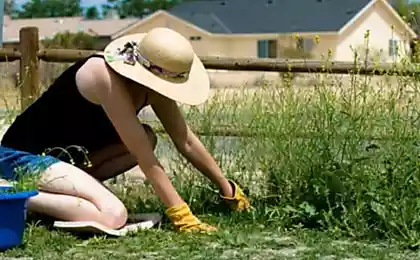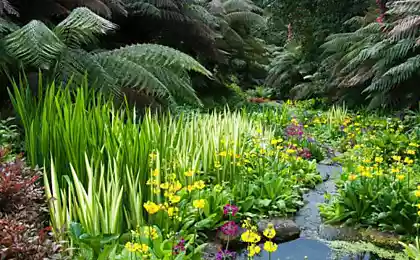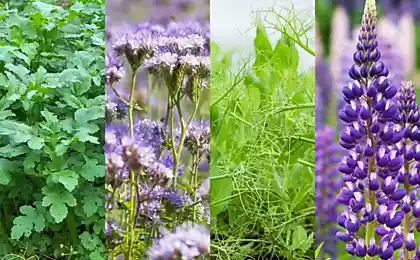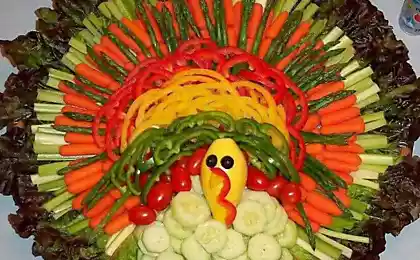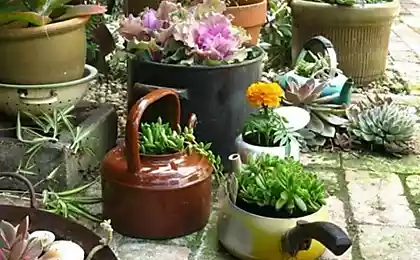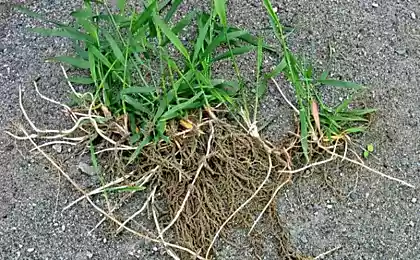1004
How to get rid of couch grass in a vegetable garden without chemicals
Quack grass is a plant pioneer. He quickly takes the territory, where the land was previously intensively processed, fertilized mineral and even organic fertilizers, and constantly plowed, cultivated, or precapitalist.
Wheatgrass usually grows in one place for up to 7 years, and then gradually gives way to other plants. But we won't wait 7 years and start to get rid of it this spring (and summer or fall, if I read an article in the summer / fall).

Some use of chemical herbicides, on the grounds that "They are allowed to use". But it is not always what is allowed, is useful. Remember that they will not bring anything good. By the way, the weeds will very quickly become accustomed to herbicides and then they need more and more rattling. Surely, you are more important than the health of their children and grandchildren than the enrichment of corporations such as chemical and pharmaceutical.
By the way, remember that Wheatgrass is not only obnoxious weed, but useful plant.
If the grass only here and there rising, it can undermine and try to choose all the roots, but this article is more about how to get rid of the couch, if he flooded a huge area.
How to deal with the couch grass on the lawn
The easiest way of dealing is used where you want to make a natural lawn. In this case you will need a tool or equipment for mowing grass (scythe, trimmer, lawn mower). By the way, the trimmer or mower even more convenient. You need to constantly mow the grass, very quickly he is tired and he will pass the baton to other plants.
A good lawn of white clover, as it is when regrowth is pretty soft and it is a pleasure to walk barefoot. And walk barefoot on the morning dew doubly enjoyable, plus even more useful.
Good also knotweed (Polygonum bird). It is soft, it is nice to step, it does not need mowing, as it grows close to the ground. Swift still likes to have it went — he breeds. Conversely, where the knotweed do not go he reluctantly grows, and then disappears.
If we grow to a normal meadow grass, too well. The important thing is that it is not Wheatgrass. Meadow grass is very good between the beds. They can be periodically cut and used as mulch for beds. By the way, between the beds of Wheatgrass for the first time is not too much of a hindrance. So its roots do not climb on the beds, you can use the border tape. First will lick the couch, walk on it and soon he will leave.
Also for the wild lawn can be used pobegovyh bluegrass and bentgrass pobedonosnaya. These plants grow rapidly and provide a nice soft carpet. Only with strong heat they can turn yellow, but after a rain once again beginning to turn green. They have a rhizome is not like wheat grass, but still they can easily climb on the bed. Therefore from them it is desirable to isolate gryadochki curb tape.
Yet it is believed that this weed does not like the neighbourhood with dahlias.
How to deal with the couch grass in the garden
The struggle with the couch grass in the garden is not so easy, but doable. The following describes the different ways of dealing with Wheatgrass and you choose those that are more suitable.
1 way. The destruction of couch-grass, choosing roots
Setting the roots of the couch grass out of the earth — all known method. The main thing here is to carefully choose the roots, it is desirable to use a shovel, and a pitchfork. This is due to the fact that even a piece of Wheatgrass rhizomes allows it to grow rapidly, and thanks to the shovel, the roots are crushed more. Besides a shovel to dig the ground overgrown with couch grass — it is almost hard labor. You will have to spend considerably more strength than digging with a pitchfork.
Disadvantage: this method requires a lot of time and effort. Almost have to iterate through each lump of earth.
2 way
This method is opposite to the first. It is recommended to grind the rhizome into small pieces (cultivator, tiller, ploughing shallow — not deeper than 20 cm). This stimulated the germination of buds that are "sleeping".
What good is it? The sprouted buds are more fragile than a grown Wheatgrass — because they take the strength to grow from small root. To choose out of the land of such plants is easier because they do not have such extensive root system as the "parent".
But you will need to work quickly with them, so they did not manage to increase its branchy root system. As soon as green shoots, they need to pull out of the ground. Farmers in traditional farming use repeated cultivation and cropping, and "combed" the rhizomes out of the station using special equipment.
Minus is the same: it takes a lot of time and effort. More than Wheatgrass can grow other weeds from seed. Additionally, the fragmentation of roots through plowing leads to destruction of the capillary structure of the soil and destruction of microorganisms that make the soil fertility. This is especially true with repeated cultivation and plowing.
Summary: in its purest form, this method is highly undesirable in natural farming.

3 way. How do I output the Wheatgrass from the garden and less to harm the earth
Similar to the second method, but with the refinement. He actually answers questions, how to get rid of couch grass with soil fertility.
After crushing roots (cultivator, tiller, ploughing shallow — not deeper than 20 cm) the site or separate beds sown with green manures, which does not like Wheatgrass. Remember that he doesn't like buckwheat, cruciferous plants and bean mixture. In fact you can use the same cover crops as for getting rid of wireworm — get a double benefit.
In addition wheat grass does not like shade, and growing cover crops will provide that shade. He does not like rye, but like wireworms, so it is not advisable to use it. In addition, rye also strongly dries up soil.
The advantage in comparison with method 2:
Although the crushing of the roots, destroys the capillary structure of the soil and killing the micro-organisms that make soil fertility, there is a positive side. Crushed roots of Wheatgrass weaker in the early growth than the Mature plant. Plus green manure with the rapid growth of shadow Wheatgrass and even inhibit the release of substances that he does not like.
Green manure will help to improve and structure the soil, nourish it with the missing substances, as well as get rid of the wireworms. Good double crops becausenow or pea-oat mixture and seeding of the oilseed radish.
This method can be used for quick recovery of a large plot. If you want to grow some vegetables this year, it will be difficult, although if you plant the seedlings, it is possible to harvest this year.
Alternatively, only part of the plot to clear this way and another part another way.
4 way
The next version — spring pruning of young plants of wheat grass. You do not need to deeply bury. Cut ploskorez Fokine's "Shear" or other familiar tool to a depth of 5-7 cm in This way will remove the grass, point of its growth and part of the rhizomes. That cut — choose from the garden — it's easier than to choose all roots to the depth of 20 cm (compared to the 1st method).
Wheatgrass rhizomes will receive a signal that you need to grow new grass and will awaken dormant buds. The grass will grow, and once you prune it the same 5-7 cm is Not eliminated and following the germination of wheat grass from the 2nd generation of dormant buds. BUT for every budding he will have less and less energy. Almost this way you drain the Wheatgrass and him, nothing will be left to die or "to crawl" in those places where it does not bother me.
Plus, this way, almost does not destroy the soil structure.
Recommendation: for greater effect, after the 2nd or 3rd before you need to plant the bed with cover crops.
Less: unlikely to have time in the spring something to sow or plant out cultivated plants. Although, after cutting the green manure can try to plant some seedlings taking into account the rotation. Also, you can substitute the green manure immediately to sow or plant crops, but that expelled Wheatgrass. Read about these 5 ways.
5 way
This method is also based on two weaknesses of Wheatgrass — intolerance to strong shading and a dislike of leguminous and cruciferous crops. In some ways it is similar to the 3rd method.
First plowing the land, but not deeper than 20 cm If the area is small then you can do a chopper or plane (e.g. in the garden). Then put the Jerusalem artichokes and sow a mixture of seeds: lettuce, radish, radish, peas, beans, corn, sunflower. Sow is not very thick, but spread. This mixture is good because it gives a chance for the grass to survive. The fact that these crops of different height and form a dense "carpet". Plus they secrete substances that do not like our beloved weed.
Get also the following advantages:
In monoculture, all these 3 plants suffer from wireworm, and in addition, and from larvae of the may beetle. But it is in traditional agriculture in the cultivation of monoculture. Likely that when growing a mixture of plants appetite the pests will disappear. I think we should conduct an experiment. It is possible in one area (the garden) to plant Jerusalem artichokes and sow a mixture of seeds of the above crops, and other garden refuse from the Jerusalem artichoke, and, possibly, maize and sunflower. So you can determine what works best.
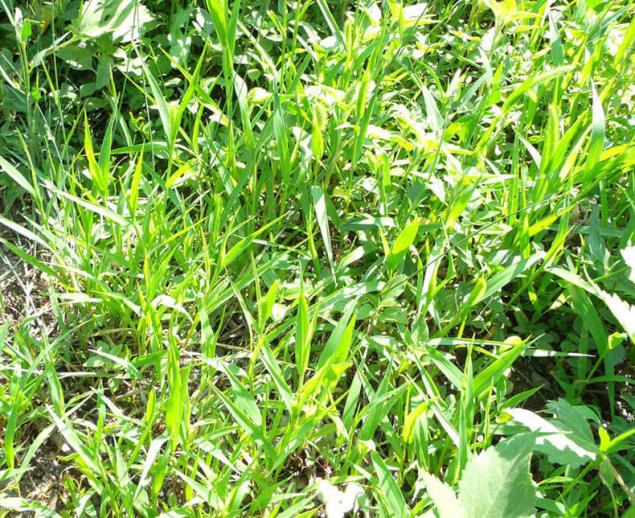
6 way
This method is also recommended by Sepp Holzer. It uses the weakness of Wheatgrass to germinate from depth. What to do? Need to remove 20 cm layer of soil with rhizomes of couch grass and other weeds and put these pieces of land are green weight down. Top with another layer with the couch to lay. Then takes the ground, poured on top of the rocks.
The total height of the ridge together with the underside layers with weeds up to 1.5 meters. The slope of the hilly beds near 60 degrees. If you consider that the top and edges of the couch will be covered with earth, it will no longer grow, and begin to humus. Probably somewhere it will sprout, but if you tightly hold the ridge vegetation, space for a couch, probably not. At any one time so get rid of it. On such a hilly ridge you need to plant a variety of plants, including those that does not like wheat grass (for example, a group of plants of 5-way)
This way you can apply with dual benefit:
1. get rid of couch grass;
2. the place where the land is selected, you can use it to warm the beds.
7 method
This method is also from the great Austrian farmers, but it is clearly not suitable for everyone. The thing is, what you intend to use pigs as "shredders" of the roots of couch grass, and various pests (wireworms, larvae of the may Khrushchev). After pigs will treat the soil, it is expected the planting of a mixture of various cultures: cereals, salads, cabbage, carrots and other vegetables.
Yes, this method is as environmentally friendly as possible, but on small plots just do not apply (at least due to the lack of specially-trained pigs).
8 method. How to destroy a couch in the garden with mulch
After place the beds, lay the 25-35 cm layer of mulch — hay, grass, any weeds (preferably without seeds, but if they are, nothing more terrible. With weed seeds can be very good bird). It is best to lay on the mulch this year. This you will achieve the following results:
1. under the mulch to form a moisture aktiviziruyutsya and perfectly reproduce a variety of earthly inhabitants, including earthworms, and thus is formed the fruitful earth;
2. Wheatgrass can pass this layer, but since its roots are located at a depth of 15 cm, he will attempt to escape "from the dungeon". Let his roots come out from the ground and it will sprout, but then the roots into the mulch layer. Then you just have to grab grass, wheat grass and pull up the roots that is not in the soil and easily pulled out. About this interesting way can hear in the video:
SUBSCRIBE to OUR youtube channel that allows you to watch online, download from YouTube free video about the recovery, the rejuvenation of man. Love for others and ourselves, as the feeling of high vibrations — an important factor
Structured recycled earth ready for sowing and planting cultivated plants in the next season. Such land not to dig, and need only to handle with plane (Fokin, swift or other) or a hoe.
Then you can either plant a mixture of plants from the 5-way or other similar plants. You can plant different crops. BUT remember the wireworm. If it is on the site, then you need to get rid of it, so the first time it is best to plant those plants which he dislikes and to sow green manures. Very good buckwheat and cruciferous plants. They are detrimental to the couch and kicked the wireworms.
9 method. The beds and flowerbeds rapid manufacturing
The attractiveness of this method in minimum effort and time. This method must not allow the Wheatgrass to get to the surface. You will need cardboard, mulch, and various garden debris, soil, compost, you can add a bit of ash. The principle of operation is shown in this picture:
1. prepare the area — if the flowerbed is framed by stones, around the perimeter you need to dig a trench for the installation of the stones. If it's a bed, border or use the tape or Board.
2. first, put cardboard, paper, old Newspapers, and pour water on them. Even better pour water with the addition of effective microorganisms. Stones or something heavy it is necessary only that the wind blew this design. If there is no wind, it is possible and without the stones to do.
3. on top of this layer put garden debris, weeds, soil mixed with compost, ash. All framed by a border of stones. Tip: it is better to set a border or frame to fill the earth. This is especially true of raised beds.
By the way, if to choose between Newspapers and cardboard, it is better to stay on the Board or, in extreme cases, black-and-white Newspapers.
How to draw patch from a practical and aesthetic point of view
The garden of Igor Liadov – the miracle, it is feasible to everyone
Then you need to cover the ridge with mulch (black agrotextile) and leave for 1-2 weeks. Or, if you have time before the main planting, sow the cover crops. After that you can start sowing seeds or planting seedlings. Important if the bed is not high, here in the first year you can plant pumpkins, squashes, watermelons (if the hot region). But here's the carrot you need to wait until next year or it will be all warped and you simply do not want it cleaned.published
Put LIKES and share with your FRIENDS!
www.youtube.com/channel/UCXd71u0w04qcwk32c8kY2BA/videos
Source: garden4u.ru/eko-sad-i-ogorod/kak-izbavitsya-ot-pyireya-bez-himii.html
Wheatgrass usually grows in one place for up to 7 years, and then gradually gives way to other plants. But we won't wait 7 years and start to get rid of it this spring (and summer or fall, if I read an article in the summer / fall).

Some use of chemical herbicides, on the grounds that "They are allowed to use". But it is not always what is allowed, is useful. Remember that they will not bring anything good. By the way, the weeds will very quickly become accustomed to herbicides and then they need more and more rattling. Surely, you are more important than the health of their children and grandchildren than the enrichment of corporations such as chemical and pharmaceutical.
By the way, remember that Wheatgrass is not only obnoxious weed, but useful plant.
If the grass only here and there rising, it can undermine and try to choose all the roots, but this article is more about how to get rid of the couch, if he flooded a huge area.
How to deal with the couch grass on the lawn
The easiest way of dealing is used where you want to make a natural lawn. In this case you will need a tool or equipment for mowing grass (scythe, trimmer, lawn mower). By the way, the trimmer or mower even more convenient. You need to constantly mow the grass, very quickly he is tired and he will pass the baton to other plants.
A good lawn of white clover, as it is when regrowth is pretty soft and it is a pleasure to walk barefoot. And walk barefoot on the morning dew doubly enjoyable, plus even more useful.
Good also knotweed (Polygonum bird). It is soft, it is nice to step, it does not need mowing, as it grows close to the ground. Swift still likes to have it went — he breeds. Conversely, where the knotweed do not go he reluctantly grows, and then disappears.
If we grow to a normal meadow grass, too well. The important thing is that it is not Wheatgrass. Meadow grass is very good between the beds. They can be periodically cut and used as mulch for beds. By the way, between the beds of Wheatgrass for the first time is not too much of a hindrance. So its roots do not climb on the beds, you can use the border tape. First will lick the couch, walk on it and soon he will leave.
Also for the wild lawn can be used pobegovyh bluegrass and bentgrass pobedonosnaya. These plants grow rapidly and provide a nice soft carpet. Only with strong heat they can turn yellow, but after a rain once again beginning to turn green. They have a rhizome is not like wheat grass, but still they can easily climb on the bed. Therefore from them it is desirable to isolate gryadochki curb tape.
Yet it is believed that this weed does not like the neighbourhood with dahlias.
How to deal with the couch grass in the garden
The struggle with the couch grass in the garden is not so easy, but doable. The following describes the different ways of dealing with Wheatgrass and you choose those that are more suitable.
1 way. The destruction of couch-grass, choosing roots
Setting the roots of the couch grass out of the earth — all known method. The main thing here is to carefully choose the roots, it is desirable to use a shovel, and a pitchfork. This is due to the fact that even a piece of Wheatgrass rhizomes allows it to grow rapidly, and thanks to the shovel, the roots are crushed more. Besides a shovel to dig the ground overgrown with couch grass — it is almost hard labor. You will have to spend considerably more strength than digging with a pitchfork.
Disadvantage: this method requires a lot of time and effort. Almost have to iterate through each lump of earth.
2 way
This method is opposite to the first. It is recommended to grind the rhizome into small pieces (cultivator, tiller, ploughing shallow — not deeper than 20 cm). This stimulated the germination of buds that are "sleeping".
What good is it? The sprouted buds are more fragile than a grown Wheatgrass — because they take the strength to grow from small root. To choose out of the land of such plants is easier because they do not have such extensive root system as the "parent".
But you will need to work quickly with them, so they did not manage to increase its branchy root system. As soon as green shoots, they need to pull out of the ground. Farmers in traditional farming use repeated cultivation and cropping, and "combed" the rhizomes out of the station using special equipment.
Minus is the same: it takes a lot of time and effort. More than Wheatgrass can grow other weeds from seed. Additionally, the fragmentation of roots through plowing leads to destruction of the capillary structure of the soil and destruction of microorganisms that make the soil fertility. This is especially true with repeated cultivation and plowing.
Summary: in its purest form, this method is highly undesirable in natural farming.

3 way. How do I output the Wheatgrass from the garden and less to harm the earth
Similar to the second method, but with the refinement. He actually answers questions, how to get rid of couch grass with soil fertility.
After crushing roots (cultivator, tiller, ploughing shallow — not deeper than 20 cm) the site or separate beds sown with green manures, which does not like Wheatgrass. Remember that he doesn't like buckwheat, cruciferous plants and bean mixture. In fact you can use the same cover crops as for getting rid of wireworm — get a double benefit.
In addition wheat grass does not like shade, and growing cover crops will provide that shade. He does not like rye, but like wireworms, so it is not advisable to use it. In addition, rye also strongly dries up soil.
The advantage in comparison with method 2:
Although the crushing of the roots, destroys the capillary structure of the soil and killing the micro-organisms that make soil fertility, there is a positive side. Crushed roots of Wheatgrass weaker in the early growth than the Mature plant. Plus green manure with the rapid growth of shadow Wheatgrass and even inhibit the release of substances that he does not like.
Green manure will help to improve and structure the soil, nourish it with the missing substances, as well as get rid of the wireworms. Good double crops becausenow or pea-oat mixture and seeding of the oilseed radish.
This method can be used for quick recovery of a large plot. If you want to grow some vegetables this year, it will be difficult, although if you plant the seedlings, it is possible to harvest this year.
Alternatively, only part of the plot to clear this way and another part another way.
4 way
The next version — spring pruning of young plants of wheat grass. You do not need to deeply bury. Cut ploskorez Fokine's "Shear" or other familiar tool to a depth of 5-7 cm in This way will remove the grass, point of its growth and part of the rhizomes. That cut — choose from the garden — it's easier than to choose all roots to the depth of 20 cm (compared to the 1st method).
Wheatgrass rhizomes will receive a signal that you need to grow new grass and will awaken dormant buds. The grass will grow, and once you prune it the same 5-7 cm is Not eliminated and following the germination of wheat grass from the 2nd generation of dormant buds. BUT for every budding he will have less and less energy. Almost this way you drain the Wheatgrass and him, nothing will be left to die or "to crawl" in those places where it does not bother me.
Plus, this way, almost does not destroy the soil structure.
Recommendation: for greater effect, after the 2nd or 3rd before you need to plant the bed with cover crops.
Less: unlikely to have time in the spring something to sow or plant out cultivated plants. Although, after cutting the green manure can try to plant some seedlings taking into account the rotation. Also, you can substitute the green manure immediately to sow or plant crops, but that expelled Wheatgrass. Read about these 5 ways.
5 way
This method is also based on two weaknesses of Wheatgrass — intolerance to strong shading and a dislike of leguminous and cruciferous crops. In some ways it is similar to the 3rd method.
First plowing the land, but not deeper than 20 cm If the area is small then you can do a chopper or plane (e.g. in the garden). Then put the Jerusalem artichokes and sow a mixture of seeds: lettuce, radish, radish, peas, beans, corn, sunflower. Sow is not very thick, but spread. This mixture is good because it gives a chance for the grass to survive. The fact that these crops of different height and form a dense "carpet". Plus they secrete substances that do not like our beloved weed.
Get also the following advantages:
- higher plants cover from the sun loving water-loving and cool neighbors (which is important in hot regions);
- the landing speed allows you to be protected from the effects of hail. Those plants that are higher, of course will suffer, but at the same time they will protect the lower culture. Accordingly, you get at least some crop that will survive.
In monoculture, all these 3 plants suffer from wireworm, and in addition, and from larvae of the may beetle. But it is in traditional agriculture in the cultivation of monoculture. Likely that when growing a mixture of plants appetite the pests will disappear. I think we should conduct an experiment. It is possible in one area (the garden) to plant Jerusalem artichokes and sow a mixture of seeds of the above crops, and other garden refuse from the Jerusalem artichoke, and, possibly, maize and sunflower. So you can determine what works best.

6 way
This method is also recommended by Sepp Holzer. It uses the weakness of Wheatgrass to germinate from depth. What to do? Need to remove 20 cm layer of soil with rhizomes of couch grass and other weeds and put these pieces of land are green weight down. Top with another layer with the couch to lay. Then takes the ground, poured on top of the rocks.
The total height of the ridge together with the underside layers with weeds up to 1.5 meters. The slope of the hilly beds near 60 degrees. If you consider that the top and edges of the couch will be covered with earth, it will no longer grow, and begin to humus. Probably somewhere it will sprout, but if you tightly hold the ridge vegetation, space for a couch, probably not. At any one time so get rid of it. On such a hilly ridge you need to plant a variety of plants, including those that does not like wheat grass (for example, a group of plants of 5-way)
This way you can apply with dual benefit:
1. get rid of couch grass;
2. the place where the land is selected, you can use it to warm the beds.
7 method
This method is also from the great Austrian farmers, but it is clearly not suitable for everyone. The thing is, what you intend to use pigs as "shredders" of the roots of couch grass, and various pests (wireworms, larvae of the may Khrushchev). After pigs will treat the soil, it is expected the planting of a mixture of various cultures: cereals, salads, cabbage, carrots and other vegetables.
Yes, this method is as environmentally friendly as possible, but on small plots just do not apply (at least due to the lack of specially-trained pigs).
8 method. How to destroy a couch in the garden with mulch
After place the beds, lay the 25-35 cm layer of mulch — hay, grass, any weeds (preferably without seeds, but if they are, nothing more terrible. With weed seeds can be very good bird). It is best to lay on the mulch this year. This you will achieve the following results:
1. under the mulch to form a moisture aktiviziruyutsya and perfectly reproduce a variety of earthly inhabitants, including earthworms, and thus is formed the fruitful earth;
2. Wheatgrass can pass this layer, but since its roots are located at a depth of 15 cm, he will attempt to escape "from the dungeon". Let his roots come out from the ground and it will sprout, but then the roots into the mulch layer. Then you just have to grab grass, wheat grass and pull up the roots that is not in the soil and easily pulled out. About this interesting way can hear in the video:
SUBSCRIBE to OUR youtube channel that allows you to watch online, download from YouTube free video about the recovery, the rejuvenation of man. Love for others and ourselves, as the feeling of high vibrations — an important factor
Structured recycled earth ready for sowing and planting cultivated plants in the next season. Such land not to dig, and need only to handle with plane (Fokin, swift or other) or a hoe.
Then you can either plant a mixture of plants from the 5-way or other similar plants. You can plant different crops. BUT remember the wireworm. If it is on the site, then you need to get rid of it, so the first time it is best to plant those plants which he dislikes and to sow green manures. Very good buckwheat and cruciferous plants. They are detrimental to the couch and kicked the wireworms.
9 method. The beds and flowerbeds rapid manufacturing
The attractiveness of this method in minimum effort and time. This method must not allow the Wheatgrass to get to the surface. You will need cardboard, mulch, and various garden debris, soil, compost, you can add a bit of ash. The principle of operation is shown in this picture:
1. prepare the area — if the flowerbed is framed by stones, around the perimeter you need to dig a trench for the installation of the stones. If it's a bed, border or use the tape or Board.
2. first, put cardboard, paper, old Newspapers, and pour water on them. Even better pour water with the addition of effective microorganisms. Stones or something heavy it is necessary only that the wind blew this design. If there is no wind, it is possible and without the stones to do.
3. on top of this layer put garden debris, weeds, soil mixed with compost, ash. All framed by a border of stones. Tip: it is better to set a border or frame to fill the earth. This is especially true of raised beds.
By the way, if to choose between Newspapers and cardboard, it is better to stay on the Board or, in extreme cases, black-and-white Newspapers.
How to draw patch from a practical and aesthetic point of view
The garden of Igor Liadov – the miracle, it is feasible to everyone
Then you need to cover the ridge with mulch (black agrotextile) and leave for 1-2 weeks. Or, if you have time before the main planting, sow the cover crops. After that you can start sowing seeds or planting seedlings. Important if the bed is not high, here in the first year you can plant pumpkins, squashes, watermelons (if the hot region). But here's the carrot you need to wait until next year or it will be all warped and you simply do not want it cleaned.published
Put LIKES and share with your FRIENDS!
www.youtube.com/channel/UCXd71u0w04qcwk32c8kY2BA/videos
Source: garden4u.ru/eko-sad-i-ogorod/kak-izbavitsya-ot-pyireya-bez-himii.html






